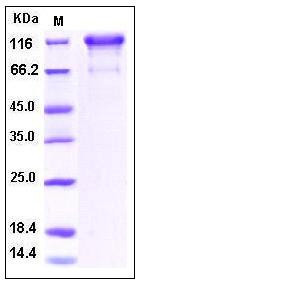Human PDGFRa / CD140a Protein (Fc Tag)
CD140A,PDGFR-2,PDGFR2,RHEPDGFRA
- 100ug (NPP4155) Please inquiry
| Catalog Number | P10556-H02H |
|---|---|
| Organism Species | Human |
| Host | Human Cells |
| Synonyms | CD140A,PDGFR-2,PDGFR2,RHEPDGFRA |
| Molecular Weight | The recombinant human PDGFRα/Fc is a disulfide-linked homodimeric protein after removal of the signal peptide. The reduced monomer consists of 739 amino acids and predicts a molecular mass of 82.9 kDa. By SDS-PAGE under reducing conditions, the apparent molecular mass of rhPDGFRα/Fc is approximately 120-130 kDa due to the glycosylation. |
| predicted N | Gln 24 |
| SDS-PAGE |  |
| Purity | > 90 % as determined by SDS-PAGE |
| Protein Construction | A DNA sequence encoding the extracellular domain (Met 1-Glu 524) of human PDGFRα (NP_006197.1) was fused with the Fc region of human IgG1 at the C-terminus. |
| Bio-activity | 1. Measured by its ability to bind human PDGF-C (P10273-H01H) in a functional ELISA. 2. Measured by its ability to bind mouse PDGF-C (P50458-M01H) in a functional ELISA. |
| Research Area | Immunology |Cytokines & Growth Factors |Growth Factor & Receptor |Platelet-Derived Growth Factor (PDGF) & Receptor |PDGF Receptor |
| Formulation | Lyophilized from sterile PBS, pH 7.4 1. Normally 5 % - 8 % trehalose and mannitol are added as protectants before lyophilization. Specific concentrations are included in the hardcopy of COA. |
| Background | PDGFRA, also known as CD140a, together with the structurally homolog protein PDGFRB (CD140b), are cell surface receptors for members of the platelet-derived growth factor family. They are members of the class III subfamily of receptor tyrosine kinase (RTKs) with the similar structure characteristics of five immunoglobulin-like domains in their extracellular region and a split kinase domain in their intracellular region. PDGFRA is expressed in oligodendrocyte progenitor cells and mesothelial cell, and binds all three ligand isoforms PDGF-AA, PDGF-BB and PDGF-AB with high affinity, whereas PDGFRB dose not bind PDGF-AA. PDGFRA plays an essential role in regulating proliferation, chemotaxis and migration of mesangial cells. Recent studies have indicated that PDGFRA acts as a critical mediator of signaling in testis organogenesis and Leydig cell differentiation, and in addition, particularly important for kidney development. Additionally, PDGFRA is involved in tumor angiogenesis and maintenance of the tumor microenvironment and has been implicated in development and metastasis of Hepatocellular carcinoma (HCC). PDGFRA may represent a potential therapeutic target in thymic tumours. PDGFRA gene amplification rather than gene mutation may be the underlying genetic mechanism driving PDGFRA overexpression in a portion of gliomas. |
| Reference |
